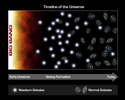
Figure 1This artist's conception illustrates the decline in our universe's "birth-rate" over time. When the universe was young, massive galaxies were forming regularly, like baby bees in a bustling hive. In time, the universe bore fewer and fewer "offspring," and newborn galaxies (white circles) matured into older ones more like our own Milky Way (spirals).
Previously, astronomers thought that the universe had ceased to give rise to massive, young galaxies, but findings from NASA's Galaxy Evolution Explorer suggest that may not be the case. Surveying thousands of nearby galaxies with its highly sensitive ultraviolet eyes, the telescope spotted three dozen that greatly resemble youthful galaxies from billions of years ago. In this illustration, those galaxies are represented as white circles on the right, or "today" side of the timeline.
The discovery not only suggests that our universe may still be alive with youth, but also offers astronomers their first close-up look at what appear to be baby galaxies. Prior to the new result, astronomers had to peer about 11 billion light-years into the distant universe to see newborn galaxies. The newfound galaxies are only about 2 to 4 billion light-years away.

